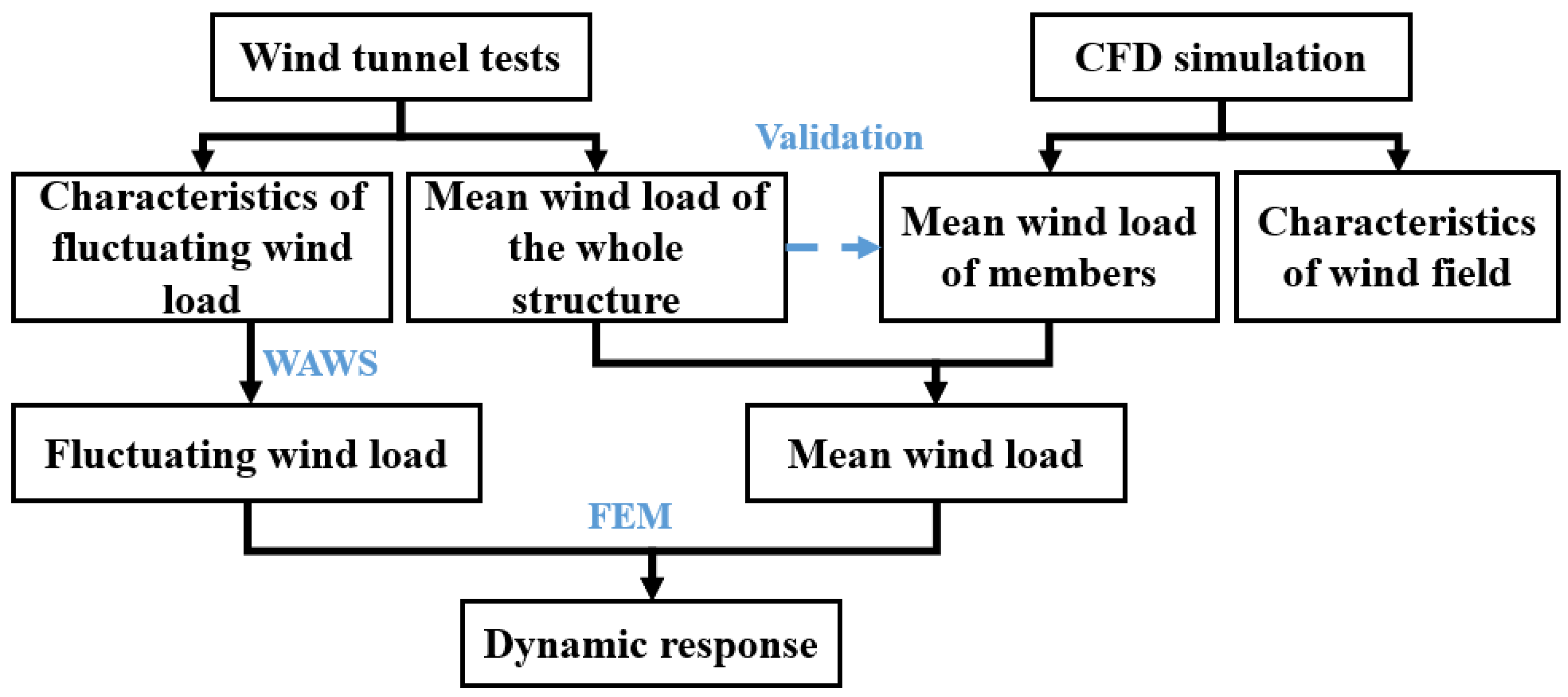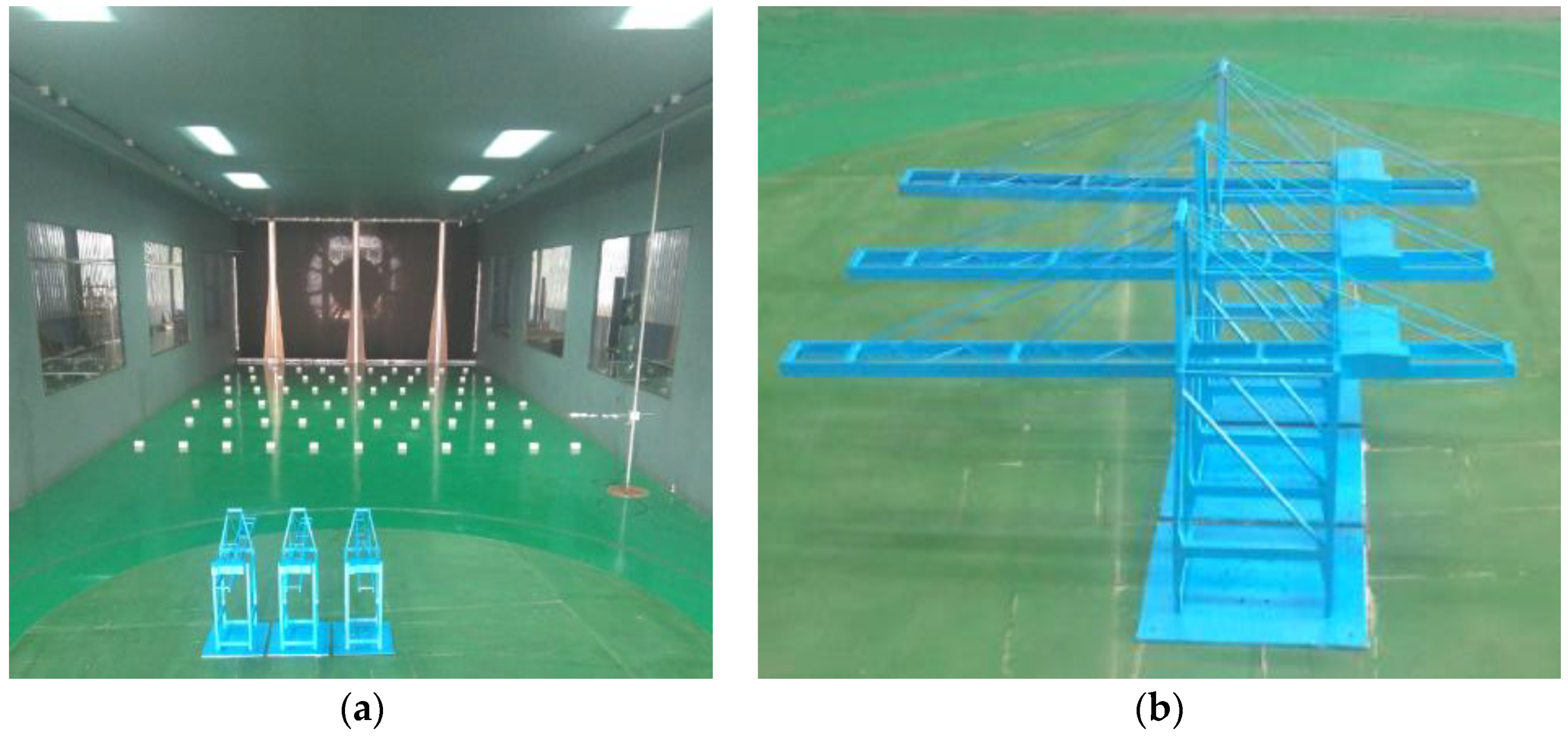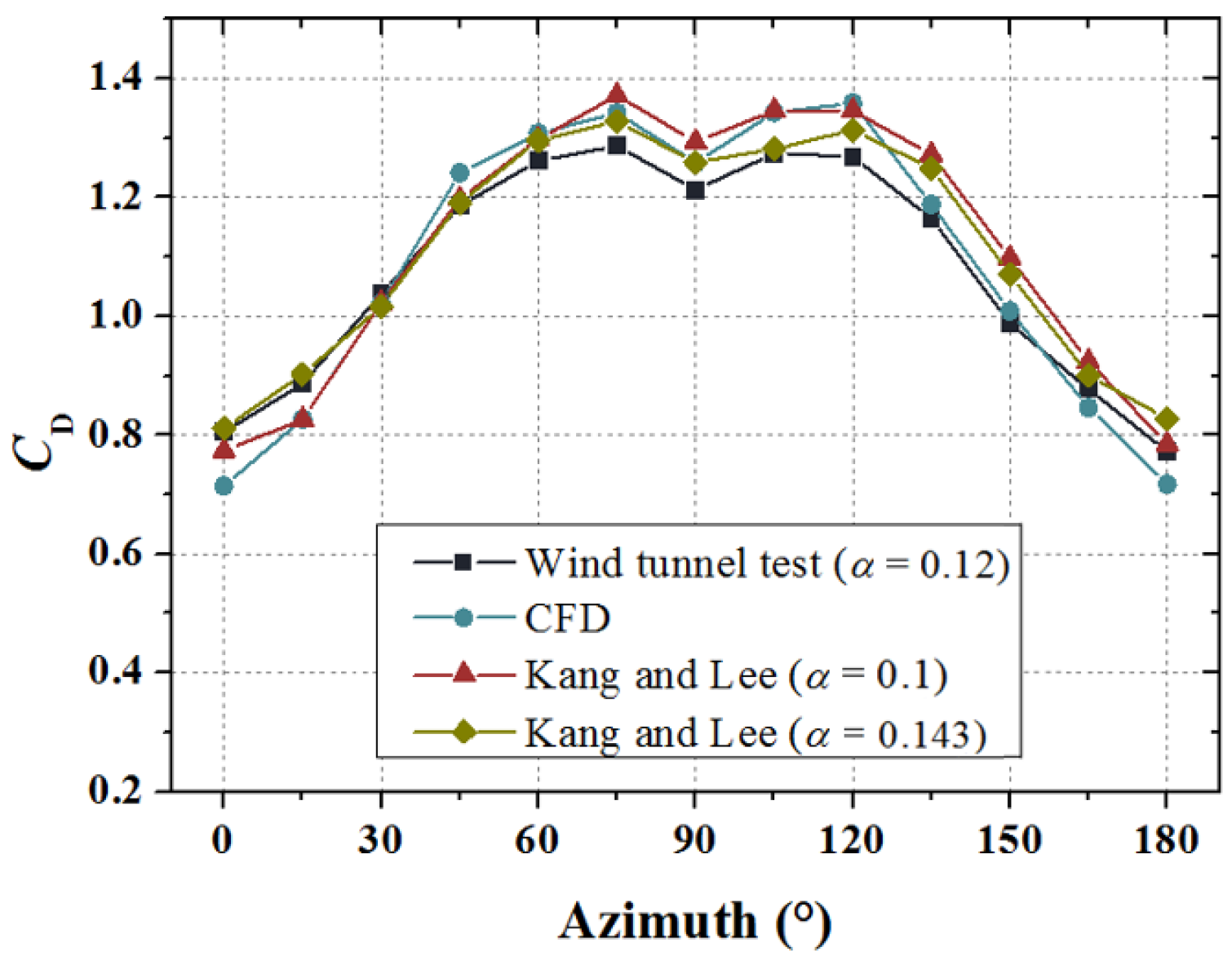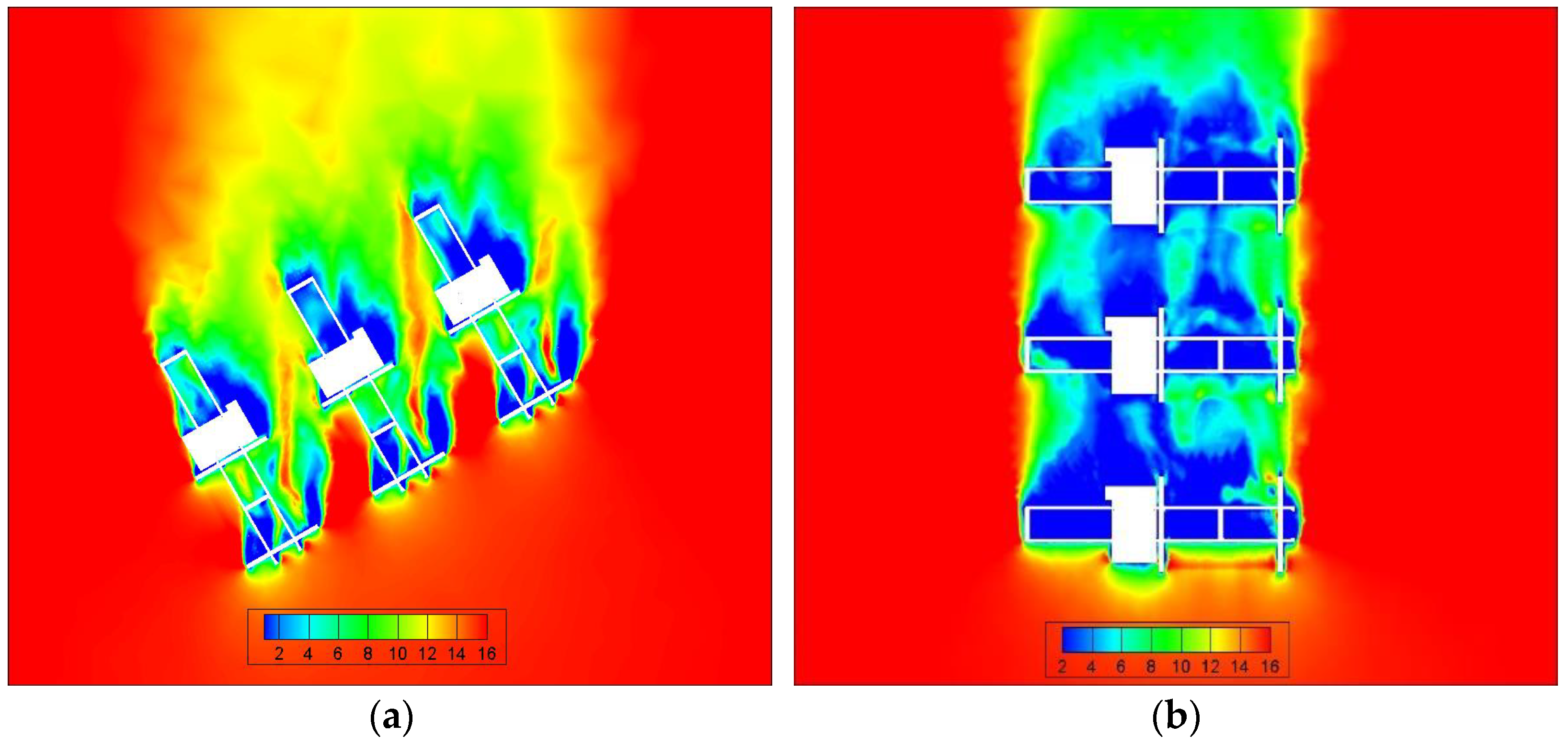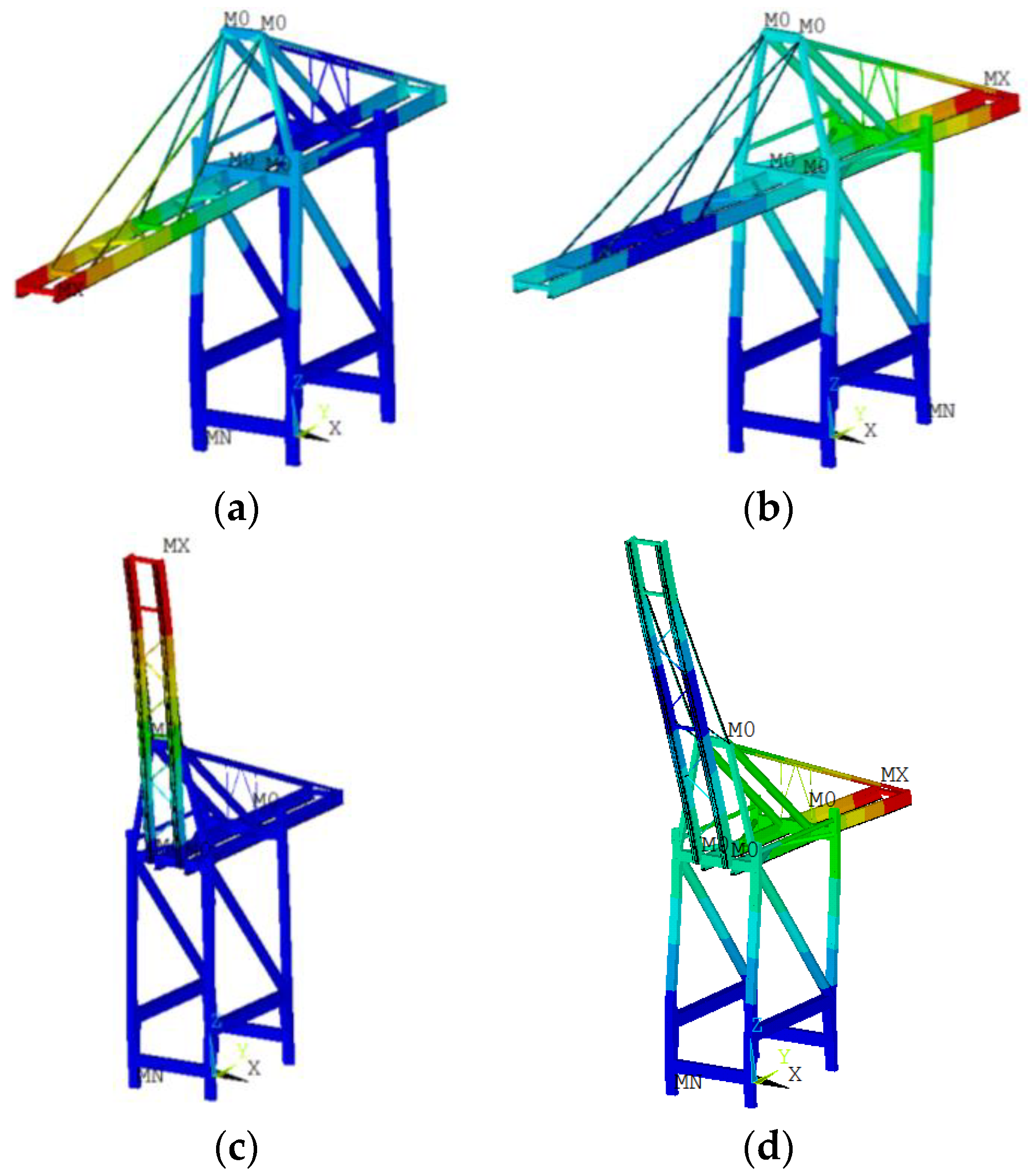3.1. Wind Tunnel Tests
To obtain the aerodynamic force data for quayside container cranes, wind tunnel tests were conducted on rigid models. A 65T-65M container crane with a weight of 1380 t was applied as the prototype as it is the most widely used type among ports and terminals. The crane has a rated lifting capacity of 65 t and a lifting height of 65 m. The geometric characteristics of the container crane model and coordinate system are displayed in
Figure 2. Both boom-down and boom-up positions were considered in the tests. Rigid models (
Figure 3) with a geometric scale of 1:150 were fabricated for the wind tunnel tests with a maximum blockage ratio of 2.7%. There are two boom positions for the crane. The boom is horizontal as a boom-down state when lifting and loading containers. The non-working resting elevation angle of 80° was set in the boom-up state when resting or suffering from windstorms or other extreme weather. Aiming to model the actual arrangement pattern in ports, three models with the same size for both boom-up and boom-down positions were provided. The measured models were made of steel with welded joints so that the models were rigid enough to avoid aeroelastic effects and fluid-structure coupling.
The balance was fixed under the center of the turn table, sharing the same position with the measured model.
Figure 3 shows the layout when measuring the wind load of the 3# crane with α = 0°. Thus, three layouts were included in one group-arrangement case (e.g., case No. 3 in
Table 1), so that all three models could be measured.
The wind tunnel tests were conducted in the boundary layer wind tunnel at Tianjin Research Institute for Water Transport Engineering (TIWTE). It is a straight-flow wind tunnel with a rectangular test section and an open area in the inlet and outlet of the tunnel. The dimensions of the wind tunnel are 4.4 m × 2.5 m × 15 m (width × height × length). In the tests, a coastal atmospheric boundary layer condition (terrain type A in Chinese code [
11]) is simulated. The simulated mean wind speed profile was set to follow the power-law profile with an exponent of
α = 0.12. The measured mean wind velocity, turbulence intensity profiles, and power spectrum density of fluctuating winds are shown in
Figure 4, which are thought to have a good agreement with the code. The boom-down model height,
H = 550 mm, was set as the reference height.
Regardless of the Reynolds number when the wind speed is beyond 5 × 10
5, the mean aerodynamic-force coefficients acting on the crane model have nearly constant values [
16]. Within this range of Reynolds number, the wind velocity is set as 10 m/s with a scale of 1:3. The wind velocity is measured in the center of the test location using a TFI Cobra Probe with a sampling rate of 1250 Hz. The reduced power spectrum of the measured wind velocity at the reference height followed the von Karman-type spectrum with an integral length scale of
H at the reference height.
To investigate the interference among the cranes, the three models with the same state were laid in a line for both states. The nondimensional spacing
S/
H is defined with center spacing
S and reference height
H. It is set as 0.484, 0.848, and 1.211, which corresponds to 40, 70, and 100 m of the center spacing in the terminals. The top view of the group-arranged crane is demonstrated in
Figure 5. The crane models are numbered 1#, 2#, and 3# along the wind direction. When suffering storms, the crane may slide along the rail according to the berthage of the ship, so that the forces along or perpendicular to the rail are always the key design parameter. Thus, the force and moment are decomposed along the body-fitted axis instead of the wind direction axis.
The test model was connected to an ATI Delta high-frequency force balance (HFFB) installed on the center of the turn table. Azimuths of 0°~180° with a step of 15° were tested. A TFI Cobra Probe was installed in the upstream direction at the reference height to measure the reference velocity
UH. As reported in previous studies (Kang & Lee [
16], Lee & Kang [
17]), the effect of the Reynolds number is negligible in such structures. The test wind speed was approximately 10 m/s at the reference height. The sampling rate (
fs) of the wind force/moment was 1000 Hz, and the duration of sampling (
Ts) was 60 s. The test cases are listed in
Table 1.
Fi and
Mi indicate the forces and moments measured along the body axes, where
i is X or Y axis. These wind force/moments were transformed into nondimensional coefficients using the following equations at each sampling time:
where
A refers to the windward projected area and
H is the reference area and reference height, respectively. The mean and root mean square (RMS) values of wind force/moment coefficients
and
are calculated by the following equations:
where
. It is the arbitrary wind force/ moment component.
N is the length of the sampling time points.
is the
i-th time point of the series. It is proved that the probability distributions of the resultant force coefficient for both isolated and group-arranged cranes obey the Gaussian distribution. And the peak force/moment coefficients
are calculated by:
where
g is the peak factor. According to the Davenport Method [
34] for calculating the peak factor of a Gaussian process, the value of which is taken as 3.
It was found that the RMS wind force/moment coefficients are usually 12~15% of the mean wind coefficients. The most unfavorable cases and the corresponding coefficient values are summarized in
Table 2. It shows that the most unfavorable cases of
CFy and
CMx always occur at 90 ± 15°, and the most unfavorable also occur at the azimuths, which deviate 15° perpendicular to the rail direction.
3.2. CFD Simulation
The CFD simulation was carried out to capture the characteristics of the wind field along the structure, aiming to find the root cause of the IE effect on wind loads. Meanwhile, the wind force of each member of each case was obtained, serving as an important supplement for the investigation of wind loads and the preparation of dynamic response calculation.
The CFD simulation was conducted using the Fluent 17.0 software platform. The 3D steady Reynolds stress model (RSM) was adopted in the computation, as it was shown to be appropriate by Huang [
15]. The coupling of pressure and velocity was computed using the SIMPLE method. The first-order dispersion scheme was applied for the moment equation, turbulent kinetic energy, and turbulent dissipation rate. According to the convergence standard, all the variables must remain below 10
−4. The same scale and test cases were adopted as those in the wind tunnel tests.
As shown in
Table 3, the CFD model is divided into 15 parts according to the category of the members in the code. Because of the complicated geometry of the model, the computational domain is divided into a cylindrical interior field and an exterior field. Unstructured tetrahedral meshes are applied in the interior area, and structured hexahedral meshes are used in the outer area (
Figure 6). The interior mesh is denser to better capture the airflow characteristics around the model. The grids are merged in nodes on the surface between two fields, so the boundary condition of the surface is set as ‘Interior’. The area around the main and diagonal members is encrypted by constructing a 10-layer boundary layer grid with an equal growth ratio of 1.1. The total number of meshes reaches 7 million. The mesh outside the interior domain is constant. So only the interior part is changed according to the model (isolated or group-arranged ones), spacing, and azimuth. The dimensions and the boundary condition of the computation domain are demonstrated in
Figure 7. The computational domain is configurated as a simple rectangular box. It has dimensions of 3.33 × 6.67 × 10 m
3 (500 × 1000 × 1500 m
3 for prototype model) to ensure the magnitude is larger than 5, 40, and 15 times of the height, width, and length of the crane model. The maximum the blockage ratio is less than 1%.
The mesh independency analysis is performed in this study. The trial test of the
CFy is performed by varying the number of meshes, and the results obtained are shown in
Table 4. Despite the number of meshes varying widely, the calculated
CFy are similar, with an error of 3.2%, and 5.38 million meshes satisfied the calculation requirements and could guarantee high calculation efficiency. After comprehensive consideration, the 7.58 million mesh scheme was conservatively used in the subsequent analysis.
For mean wind velocity
U (in m/s), the target vertical profile is the same as the wind tunnel one. The velocity inlet is set according to the following equations:
with
zref = 550 mm (equal to
H),
Uref = 10 m/s and
α = 0.12. As shown in
Figure 8, the CFD inlet profiles for mean wind velocity and turbulence intensity agree well with that specified in the codes. The vertical profile of turbulent kinetic energy
k over height
z is calculated based on the target mean velocity profile and the turbulence intensity above the ground.
The turbulence dissipation rate
ε (m
2/s
3) is calculated as
where
κ is the von Karman constant (
κ = 0.4) and
u* the friction velocity calculated by
The aerodynamic roughness length for the ground plane of the domain representing water was derived from the updated Davenport roughness classification z
0 = 0.0002 m [
35]. The test cases of the CFD simulations can cover those of wind tunnel tests. Furthermore, the spacing of the model in the CFD cases is smaller for both two crane states, which is set as 40~100 m with a step of 10 m.
The mean drag coefficient values for the boom-down crane in the wind tunnel test are shown in
Figure 9. For comparison, the results of Kang and Lee’s [
16] wind tunnel test with the pow-law exponents of 0.143 and 0.1 are also demonstrated in the figure. The results obtained in the current study are in good agreement with previous investigations. The most unfavorable azimuth is 75° for the boom-down state in the wind tunnel tests, which also corresponds with the conclusions drawn by Kang and Lee [
16]. Additionally, the wind force of each member was obtained and validated by wind tunnel tests, and the results were applied when calculating the wind-induced response. Moreover, the force and moment coefficients of CFD simulation in all cases were compared with that of the wind tunnel tests to check the accuracy. As shown in
Figure 10, the force coefficient of 3# crane in case 3 was demonstrated and showed that the results agreed well.
3.3. Stochastic Simulation
Based on the wind tunnel tests, the wind force of the individual members was assumed to have the same wind load characteristic as that of the whole body (Xiao et al. [
18]). In addition, the same mean root square of wind force was used. Katagiri [
36] noted that the nondimensional auto-power spectrum of the wind load is independent of the height. Thus,
can be expressed as follows:
where
is the nondimensional auto-spectrum,
is the RSM of the wind force of each member (assumed to be the same as that for the whole structure), and
is the height of the
i-th member (determined according to [
37]). The cross-power spectrum
can be simplified as
where
[
37] is the coherence function of the wind load between members.
and
is the coordinate of the
i-th and
j-th member. It is related to the position of the member. Therefore, the spectrum of the base moment can be deduced as
according to Equation (11), it can be expressed as,
Thus,
where the spectrum of the base moment
can be deduced by the results of the HFFB tests. According to Equation (14), the wind force history of members can be generated according to the moment spectrum and the fluctuating wind force coefficients obtained in the wind tunnel tests. Based on the above deduction, the WAWS was carried out and wind load time history of each member was obtained. Each element in the FEM model, corresponding to each member, was meshed uniformly with several nodes. The wind load of the member was distributed uniformly on nodes attached on it. The wind load time history on the top point of the boom-down crane generated by WAWS is shown in
Figure 11. As shown in
Figure 12, the sum of the members’ wind force time history is calculated as the base shear force, which was compared with the results of the wind tunnel tests of the corresponding case.
